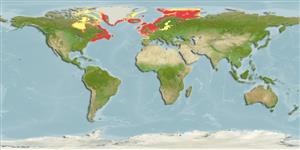Common names from other countries
Environment: milieu / climate zone / depth range / distribution range
экология
морской; солоноватоводный демерсальный; пределы глубины 0 - 451 m (Ref. 58496). Polar; 80°N - 40°N, 95°W - 60°E
Eastern Atlantic: south-eastern coasts of Greenland, Jan Mayen Island, Iceland to British Isles and southward to Bay of Biscay, also North Sea, Baltic Sea, Spitsbergen and southern part of Barents Sea (including White Sea). Western Atlantic: James Bay in Canada to New York, USA (Ref. 7251). Arctic Ocean.
Length at first maturity / Size / Вес / Возраст
Maturity: Lm 17.8, range 15 - 30 cm
Max length : 60.0 cm TL самец/пол неопределен; (Ref. 9925); common length : 24.0 cm SL самец/пол неопределен; (Ref. 4698); наибольший возраст (опубликованны данные): 18 годы (Ref. 122394)
колючие лучи спинного плавника (общее число) : 7 - 11; членистые (мягкие) лучи спинного плавника (общее число) : 13 - 19; колючие лучи анального плавника: 0; членистые (мягкие) лучи анального плавника: 9 - 15; позвонки: 34 - 39. Caudal fin rounded. Greenish brown above, often with dark blotches and bright milky-white spots above pectoral fins; underside cherry red (males) or light orange (females) with white spots; fins with dark bands (Ref. 4698).
Found on rocky bottoms with sand or mud, or among seaweeds (Ref. 4698). Benthic (Ref. 58426). Feeds on fishes, large crustaceans, occasionally polychaetes and amphipods (Ref. 4698). During the spawning season, the male's underside becomes deep red with white spots.
Eggs are deposited in a clutch on the bottom and defended by the male. Larvae hatch after about 5 weeks.
Fedorov, V.V., 1986. Cottidae. p. 1243-1260. In P.J.P. Whitehead, M.-L. Bauchot, J.-C. Hureau, J. Nielsen and E. Tortonese (eds.) Fishes of the North-eastern Atlantic and the Mediterranean. UNESCO, Paris. Vol. 3. (Ref. 4698)
Статус Красного Списка МСОП (Ref. 130435)
CITES (Ref. 128078)
Not Evaluated
Угроза для людей
Harmless
Использование человеком
рыболовство: коммерческий; аквариум: общественные аквариумы
дополнительная информация
инструменты
Специальные отчеты
Скачать в формате XML
ресурсы в Интернет
Estimates based on models
Preferred temperature (Ref.
115969): 0.4 - 10.3, mean 4.5 (based on 1225 cells).
Phylogenetic diversity index (Ref.
82804): PD
50 = 0.5000 [Uniqueness, from 0.5 = low to 2.0 = high].
Bayesian length-weight: a=0.00871 (0.00720 - 0.01054), b=3.15 (3.09 - 3.21), in cm Total Length, based on LWR estimates for this species (Ref.
93245).
Trophic level (Ref.
69278): 3.9 ±0.0 se; based on diet studies.
устойчивость к внешним воздействиям (Ref.
120179): средний (среднего размера), минимальное время удвоения популяции 1.4-4.4 года (tm=2; Fec=2,742).
Fishing Vulnerability (Ref.
59153): Low to moderate vulnerability (34 of 100).
